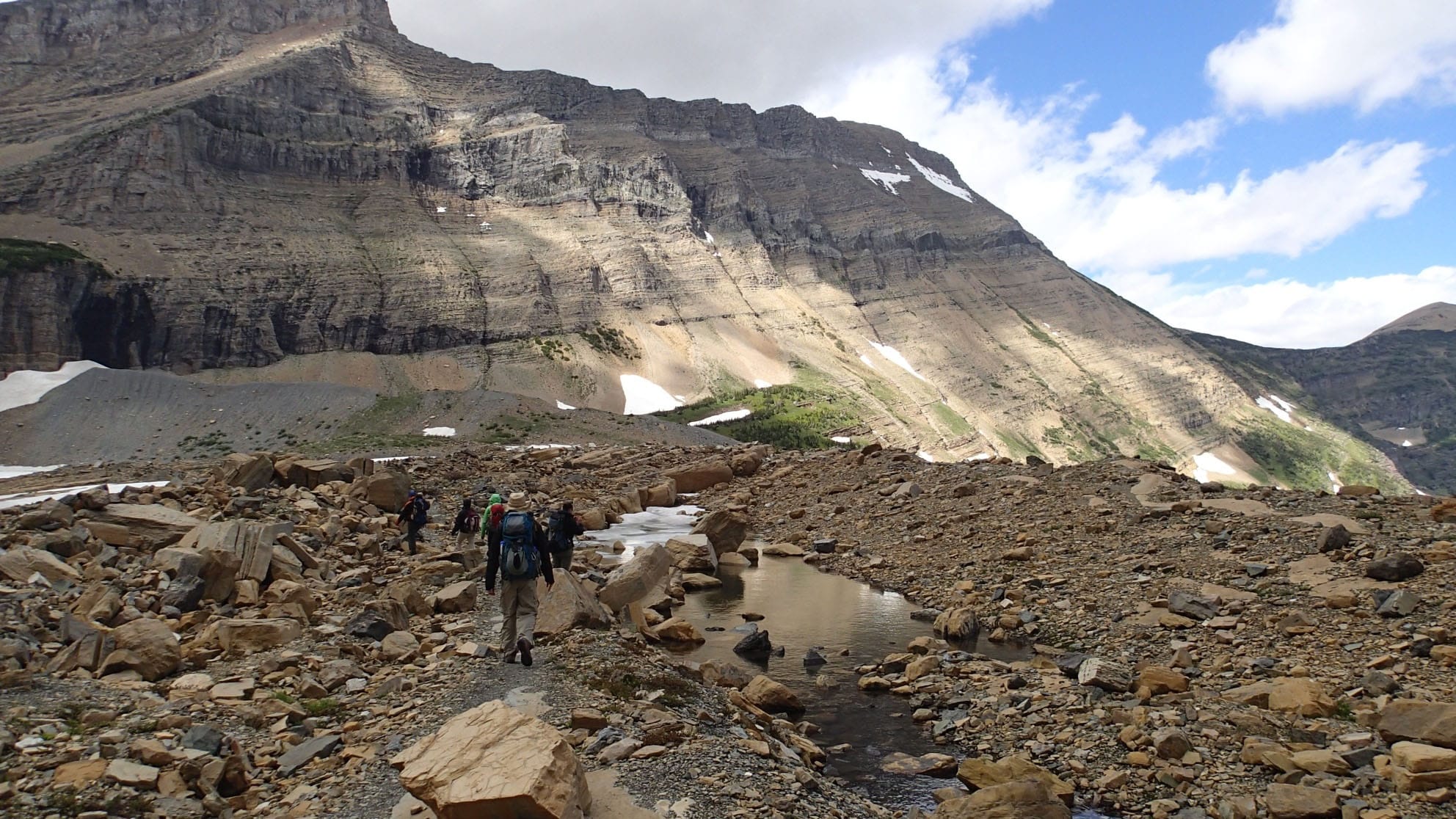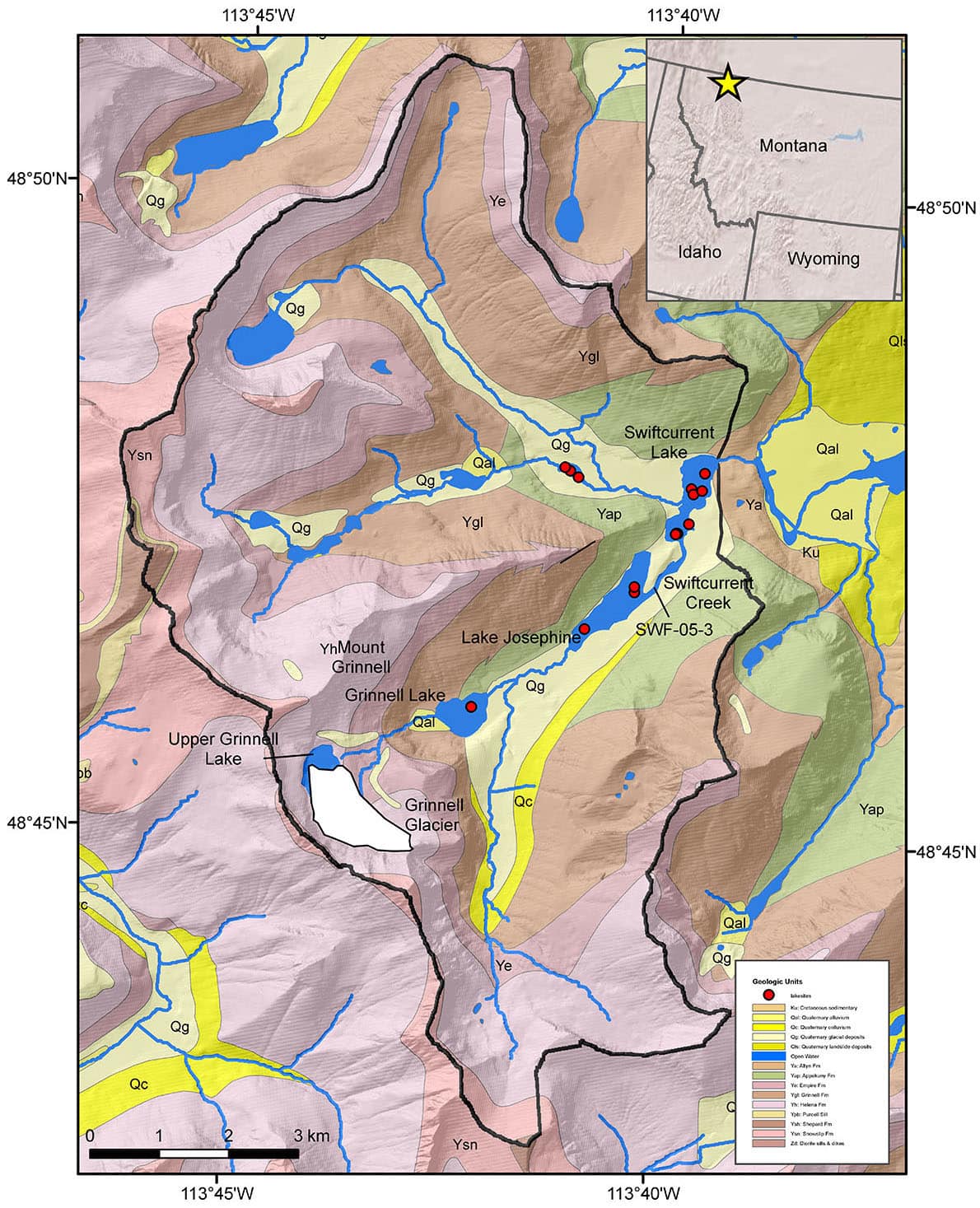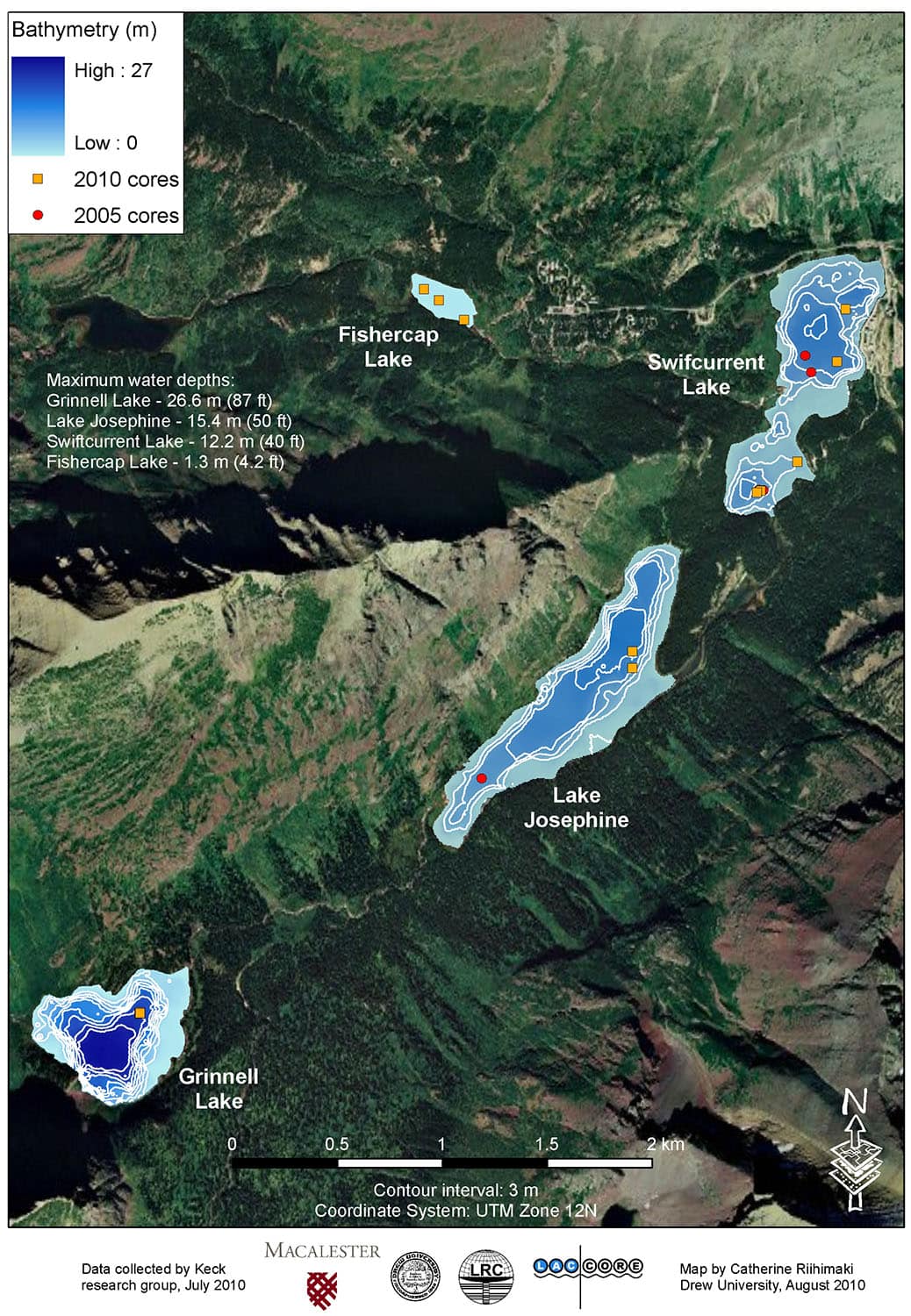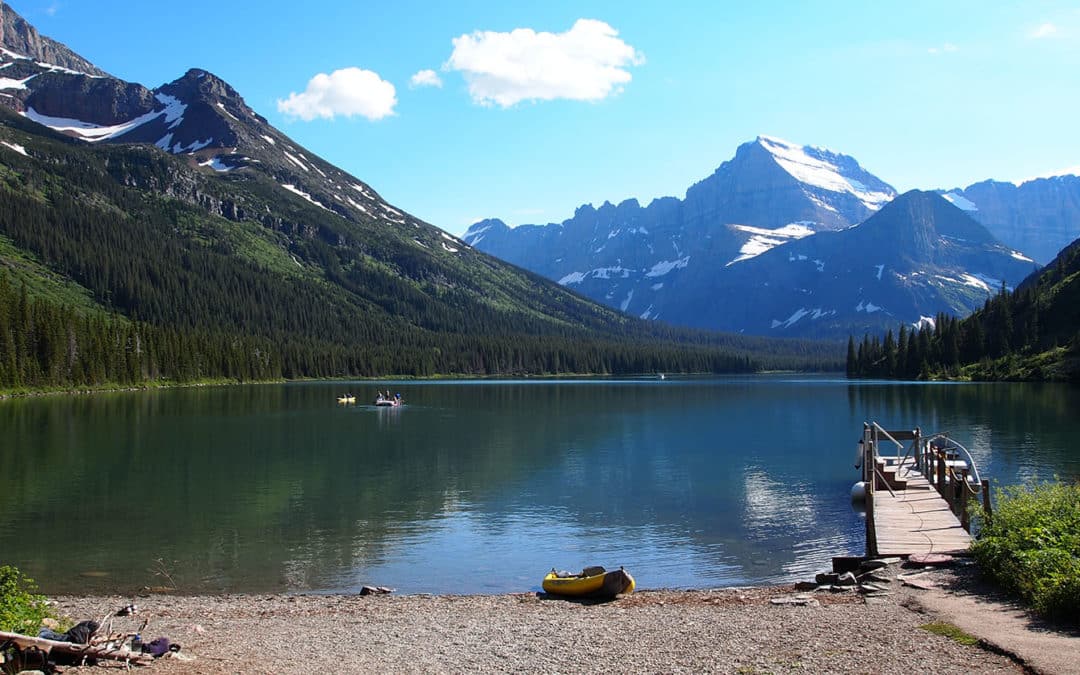Landscape and environmental change in Glacier National Park, Montana
Overview: This eight-student project uses sediment core samples to reconstruct glacial history, Holocene climate, and human impacts to Glacier National Park, Montana (GNP). Chains of lakes in glacial valleys collect the sediment produced by the glaciers and surrounding landscapes, providing a detailed record of glacier advance and retreat, climate, ecology, geomorphology, and land use change from the Pleistocene through the Anthropocene. Building on previous Keck student projects in 2010 and 2014, and coring/sampling in new sites, students will use mineralogy to reconstruct glacier size, organic carbon to investigate human impacts, microscopic charcoal fragments to build a record of past wildfire frequency, and multisensor instrumentation to discern geochemical differences between lakes with differing degrees of human impact. The group will have the opportunity to talk about their research with Park staff and the public.

Geologists hiking through the high country of Glacier National Park
When: July 8 – August 11, 2018 (tentative)
Where: St. Paul/Minneapolis, Minnesota (introduction and lab work) and Glacier National Park, Montana (field work)
Who: Eight students and project leaders Dr. Kelly MacGregor (Macalester College, macgregor@macalester.edu), and Dr. Amy Myrbo (LacCore/CSDCO, University of Minnesota, amyrbo@umn.edu)
Prerequisites and Recommended Courses: Because this experience is targeted for students early in their academic careers, there are no specific coursework prerequisites. We are seeking students who are interested in many or all of the following: limnology, geomorphology, glaciers, wildfires, human impacts to lake ecosystems, natural and manmade climate change, erosion and sedimentation, and using field and laboratory methods to explore scientific questions about Earth surface processes.
Ideally, students will have some comfort with (or willingness to experience!) sharing close quarters in tents in cold and sometimes rainy weather, boating and swimming, communicating with the public and tourists ‘on the spot,’ hiking up to 12 miles in a day (typically 4-5 miles a day), and being without cell phone coverage for up to a week. Students will need to maintain composure in field conditions that are safe but that may include bad weather, difficult trail and boat conditions, and wildlife (including bears). Support in the form of field gear loans will be provided to students who do not own their own. All tents and cooking gear will be provided.
Expectations and Obligations:
1. Participation in all project-related work during the summer (approximately July 8-August 11, 2018)
2. Write a team abstract and present a paper (poster or talk) at the Geological Society of America National Meeting in Indianapolis, IN November 4-7, 2018 (all expenses covered).
PROJECT DESCRIPTION
This project utilizes the remote and relatively pristine landscape of Glacier National Park, Montana as a natural laboratory for understanding the impacts of climate change on alpine landscapes, both natural (e.g., glacial-interglacial cycles, Little Ice Age) and anthropogenic. Understanding controls on past climate variability is key to assessing potential future environmental change. The climate history of the northern Rocky Mountains is known primarily from lacustrine paleoecological records that are widely spaced in Montana, Idaho, and Wyoming (e.g., Karsian, 1995; Doerner and Carrara, 1999; Millspaugh et al., 2000; Doerner and Carrara, 2001; Brunelle and Whitlock, 2003; Hofmann et al., 2006; Shapley et al., 2009). In 2005, 2010, and 2014, we collected lake cores in Swiftcurrent Lake, Lake Josephine, and lower Grinnell Lake, all of which are located downstream of Grinnell Glacier in the Many Glacier region of Glacier National Park, Montana (Figure 1). Work done on these cores by previous students (many of them as part of Keck projects) has provided additional constraints on climate and environmental history in the basin since the end of the Last Glacial Maximum. For example, a continuous core from Swiftcurrent Lake spanning ~17,000 years demonstrates a strong link between climate in the basin and solar forcing on centennial timescales (MacGregor et al., 2011), as well as links between glacier size and detrital dolomite in the lakes (Schachtman et al., 2015). A manuscript in preparation (including two Keck students as co-authors) explores the fire history of the region during the Holocene and demonstrates a link between fire frequency and increased geomorphic activity on the surrounding hillslopes. Another manuscript examines changes in the carbon signatures in lake sediment as a result of human activities in the Park over ~150 years.

Figure 1.
This year, our project will focus on the collection of short lake core transects (top ~50 cm of sediment at the lake bed) in a suite of lakes in the Many Glacier and Swiftcurrent valleys to understand environmental and landscape change over the past several centuries. These cores will allow us to: 1) provide enhanced spatial resolution of dolomite transport in the proglacial hydrologic system to enhance our understanding of the relationship between hillslope processes, glacial erosion, and lake transport and sedimentation; 2) measure the presence and concentration of charcoal in the lakes as a result of forest fires from summer 2017 and 2015 and compare the severity to Holocene fires; 3) assess the human impacts on the watershed through collection and dating of near-surface sediments; and 4) understand the hydrologic and sedimentologic transport of basin sediment in two contrasting geomorphic valley systems (one with deep glacial lakes and the other with primarily shallow paternoster lakes). We also plan to collect basic lake chemistry data to examine modern environmental conditions in the lakes.
There is broad interest in the future of our National Park system, as well as the response of glaciers to climate change. Visitation in National Parks continues to grow each year, with record numbers in 2017 (https://e360.yale.edu/features/greenlock-a-visitor-crush-is-overwhelming-americas-national-parks). Glacier National Park is sensitive to climate change through glacial retreat (e.g., Key et al., 2002) and ecosystem adjustments (e.g., Klasner and Fagre, 2002), and there is widespread interest in the effects of future climate change in this unique and public space. This research project is aimed at understanding environmental and climate change in a near-pristine alpine basin in North America and will collect data relevant to the debate about the impacts of humans on remote landscapes. The research has relevance to communities in geomorphology, Quaternary geology, glaciology, and paleoclimatology, as well as to the general public interested in the impacts of climate change.
Study Area
The Many Glacier region of Glacier National Park in northwestern Montana has been our research site for the past 14 years. For the 2018 field season we will add the Swiftcurrent Valley and its lakes to our ongoing research area of the adjacent Grinnell Valley. Glaciers that have diminished significantly since the 19th century occupy the heads of both of these valleys.
Goals and Significance of the Project
- Students will gain foundational knowledge of a) formation of sedimentary and intrusive igneous rocks, b) regional metamorphism and mountain building, c) climate variability during the Pleistocene, d) glacier dynamics and subglacial/supraglacial erosion, and e) sediment transport and deposition in glacial lake systems.
- Students will learn to read and interpret topographic and geologic maps, including locating themselves in the field.
- Students will learn to make measurements of active processes and collect samples with an understanding of WHY the data/results are important/interesting.
- Students will learn how to explain the relevance of their research project to a variety of people (peers in the field, Park visitors, Park Rangers, peers at the national GSA meeting, users of the Flyover Country mobile app for geoscience).
- Students will be able to identify ways in which their own life affects (and is affected by) interactions with the Earth (Fink, 2003).
- Students will learn how to be an effective team member in the context of both the field and the laboratory.
- Students will learn about the scientific process, including the role of problem-solving, creativity, quantitative reasoning, and revision in science.
- Students will gain confidence in their abilities as a scientist, including working in the field and the lab.
Potential Student Projects
In summer 2018, we envision a wide range of possible student projects. We plan to have the students work on projects in pairs based on their interests. We also recognize that there are situations that can alter research plans (i.e., weather, trail closures due to bears, forest fires, equipment malfunction, etc.), and we have ‘backup’ projects based on sediment cores we have already collected.
- Detrital minerals as a proxy for glacier size: Previous work suggests dolomite (present only beneath Grinnell Glacier and along the Continental Divide) can be used as a proxy for glacier size (MacGregor et al., 2011; Schachtman et al., 2015). However, we do not fully understand the role that upstream lakes may play in filtering dolomite along its transport path. A detailed analysis of dolomite presence over time in a downstream transect of gravity cores (the top ~20-70 cm of sediment) in both the Grinnell Glacier and adjacent Swiftcurrent valleys would provide important details about dolomite transport and deposition. In addition, the grain size of dolomite as compared to the quartz and chlorite/illite fraction in the sediments needs to be investigated to model grain transport. This could be investigated through smear slide analysis, loss on ignition (LOI), color analysis of the core scans, and XRD as part of several projects.
- In addition to examining detrital minerals, students can conduct LOI measurements to determine the organic carbon fraction of lake sediments. Comparing LOI at two sites, or along a valley transect, can provide data that reflect the amount of organic carbon inputs into the lakes and how that varies in space and time. This speaks to both modern climate change and possibly human impacts on the Park landscape.
- Fire history & modern fire records: Large fires occurred within the Park boundary in 2015 and again in 2017. With permission from the Park, we would like to sample from a lake more proximal to the 2017 Sprague fire (Lake Ellen Wilson or Avalanche Lake); surface cores collected from the two valleys in Many Glacier are also likely to produce records of fires in the past several hundred years. Transects of charcoal records could illuminate transport of charcoal particles in high-relief alpine systems, which has not been the focus of previous research. If there is interest, we may try to search for microplastic spherules in the lake sediments as markers of the Anthropocene.
- Timing of fires: We propose to collect ~4 new 19th-21st century cores to provide high resolution age control and to allow for detailed analyses of the historic time period in this lake. Students could compare sedimentation rates and patterns higher up in the Grinnell/Swiftcurrent valleys.
- Modern lake processes: portable hydrolabs can measure dissolved oxygen, pH, turbidity, conductivity, temperature, and other metrics. Comparisons between glacier-fed and unglaciated lakes could be made, as well as comparisons of human-proximal and human-distal regions of the valley. In addition, they can make comparisons between measurables in GNP lakes and those in other alpine systems affected by climate change (e.g., Fink et al., 2016).

Figure 2.
PROJECT LOGISTICS
Our tentative dates are July 8-August 11, 2018.
We will meet in Minneapolis/St. Paul and spend 5-6 days at the dorms at Macalester College for classroom and laboratory ‘crash courses’ to prepare for the field work and research projects. This will include mini-lectures, hands-on activities, talks by faculty and researchers in the geosciences at the U of M and Macalester, and training at LacCore. Material presented will bring all students up to speed on the geoscience background for the project, including the geologic evolution of the Park, global climate change, and surface processes. While many of these topics will be introduced during the beginning of the project, we expect this learning will continue during our travel and in the field.
We will spend two days driving to Many Glacier (camping on the way), where we will set up camp. We plan to cook most meals in the campground during our ~12-14 days camping. The first several days in the field will be spent giving the group an overview of the geology, biology, and history of the Park, as well as reading about use conflicts between the Park and the Blackfoot Indian community in the region. The group will watch a training video on bear safety at the Many Glacier Ranger Station and learn to safely hike and camp in the Park. We plan to travel and hike (up to 12 miles/day) in other parts of the Park, including Logan Pass (continental divide) and West Glacier (near the major 2017 fires). Collection of lake cores, water sampling, and any additional mapping/sampling will be conducted in small groups over the course of 5-7 days. As we have done each summer working in the Park, the group will present our past findings and current projects to the Park Rangers during our stay. We also anticipate daily interactions between students and the public.
After returning to the Twin Cities, students and peer mentors will again stay at Macalester and drive daily to LacCore, where they will split, log, photograph, and describe the cores in accordance with standard limnogeological community procedures. Core description will provide much of the needed basis for answering research questions; students will collect samples and begin to conduct analyses for their projects. During this time, the group will shop and cook dinners together, independent of the project leaders but with the help of a peer mentor.
GNP SAFETY ISSUES
MacGregor and Myrbo are experienced field scientists with experience in similar landscapes across the globe. They are familiar with safety issues specifically related to bears, alpine weather conditions, and boating. There is little question that there are a host of inherent risks in this proposed work, but we will try to minimize this risk through training, communication, assessment of student abilities, and planning. Here we briefly address the most common concerns.
Bears: We will spend the bulk of our field time camping in bear country, with large populations of both black and grizzly bears. Students will be trained by Park rangers in proper food storage and camping/hiking safety. Each team of students/researchers will carry pepper spray and travel in groups of 4-5 for the majority of the field work. Note that past projects have all encountered bears at a safe distance, as well as sightings of moose and even wolverines.
Boats: To collect samples of sediment and other physical measurements of lake water, we will be using non-motorized inflatable boats, including kayaks. Students are required to wear life jackets at all times, and the lakes are small enough in size that the shorelines are always visible. Students will always boat with at least one other person, with clear communication about the planned route and expected time on the water.
Weather/conditions: The weather in the Park can be quite unpredictable and variable, with some days up to 80° F and others at/near freezing temperatures. Heavy rain and wind, hail, and snow are all possible, as are very hot sunny days. Warm clothing and layers are all necessary, including rain gear. A day pack (medium sized backpack) is important for all students so they can carry sufficient clothing and food every day, including 2-3 large water bottles. Suncreen, winter hats and gloves, sunglasses, and sturdy hiking shoes/boots are key for student safety and comfort.
PROFESSIONAL DEVELOPMENT
Conducting a research project at an early career stage is not only a résumé-builder, but helps to develop many skills that are applicable after the summer is over. Working and living together in the field, collaboratively completing a project from start to finish, and starting to develop a network of friends and colleagues all build resiliency, capabilities, and cognitive abilities. This Gateway Keck project offers these experiences in a supportive yet challenging environment. Students will work on real scientific questions, using standard and state-of-the art field and lab equipment; they will also receive training in science communication, including informal interactions with the public in the field, and more formal methods of presenting information such as lightning talks and giving better, more engaging research presentations.
References
Anderson, H., MacGregor, K.R., Oddo, P., Riihimaki, C., Williams, C., Myrbo, A. (in prep). Little Ice Age and human impacts in eastern Glacier National Park, Montana, USA. Proceedings of the National Academy of Sciences.
Brunelle, A. and Whitlock, C., 2003. Postglacial fire, vegetation, and climate history in the Clearwater Range, northern Idaho, USA. Quaternary Research 60, 307-318.
Brunelle, A. et al., 2005. Holocene fire and vegetation along environmental gradients in the northern Rocky Mountains. Quaternary Science Reviews 24, 2281-2300.
Carrara, P.E., 1995. A 12000 year radiocarbon date of deglaciation from the Continental Divide of northwestern Montana. Canadian Journal of Earth Sciences 32, 1303-1307.
Carrara, P.E., 1993. Glaciers and glaciation in Glacier National Park, Montana. Open-File Report 93-510, 1-18.
Carrara, P.E., 1990. Surficial geologic map of Glacier National Park, Montana.1:100,000, .
Carrara, P.E., 1989. Late Quaternary and vegetative history of the Glacier National Park region, Montana.1902, 64 p.
Carrara, P.E., 1987. Holocene and latest Pleistocene glacial chronology, Glacier National Park, Montana. Canadian Journal of Earth Sciences 24, 387-395.
Craig, D.R., Yung, L., Borrie, W.T., 2012. “Blackfeet Belong to he Mountains”: Hope, Loss, and Blackfeet Claims to Glacier National Park, Montana. Conservation and Society, Vol. 10 (3), p. 232-242. DOI: 10.4103/0972-4923.101836
Doerner, J.P. and Carrara, P.E., 2001. Late quaternary vegetation and climatic history of the Long Valley area, west-central Idaho, U.S.A. Quaternary Research 56, 103-111.
Doerner, J.P. and Carrara, P.E., 1999. Deglaciation and postglacial vegetation history of the West Mountains, west-central Idaho, U.S.A. Arctic, Antarctic, and Alpine Research 31, 303-311.
Earhart, R.L. et al., 1989. Geologic maps, cross section, and photographs of the central part of Glacier National Park, Montana.
Fink, G., Wessels, M., Wuest, A., 2016. Flood frequency matters: Why climate change degrades deep-water quality of peri-alpine lakes. Journal of Hydrology 540, 457-468.
Hanauer, D.I., Graham, M.J., Hatfull, G.F. 2016. A Measure of College Student Persistence in the Sciences (PITS). CBE-Life Sci Educ vol. 15, no. 4, ar54. doi: 10.1187/cbe.15-09-0185CBE
Hofmann, M.H. et al., 2006. Late Pleistocene and Holocene depositional history of sediments in Flathead Lake, Montana; evidence from high-resolution seismic reflection interpretation. Sedimentary Geology 184, 111-131.
Horodyski, R.J., 1983. Sedimentary geology and stromatolites of the Mesoproterozoic belt
Supergroup, Glacier National Park, Montana. Precambrian Research 20.
Karsian, A.E., 1995. A 6800-year vegetation and fire history in the Bitterroot Mountain Range, Montana. MSc. Thesis, University of Montana, Missoula. 54 p.
Key, C.H., D.B. Fagre, R.K. Menicke. 2002. Glacier retreat in Glacier National Park, Montana. In R.S. Williams and J.G. Ferrigno, eds., Satellite image atlas of glaciers of the world: North America. U.S. Geological Survey Professional Paper 1386-J, U.S. Government Printing Office, Washington D.C. p 365-381.
Klasner, F. L. and D. B. Fagre. 2002. A half century of change in alpine treeline patterns at Glacier National Park, Montana, U.S.A. Arctic, Antarctic, and Alpine Research. 34(1):53-61.
MacGregor, K.R., Riihimaki, C.A., Myrbo, A., Shapley, M.D., Jankowski, K. 2011. Geomorphic and climatic change over the past 12,900 years at Swiftcurrent Lake, Glacier National Park, Montana. Quaternary Research, 75(1), doi:10.1016/j.yqres.2010.08.005.
MacLeod, D.M. et al., 2006. A record of post-glacial moraine deposition and tephra stratigraphy from Otokomi Lake, Rose Basin, Glacier National Park, Montana. Canadian Journal of Earth Sciences 43, 447-460.
Mehringer, P.J.,Jr et al., 1984. The age of Glacier Peak tephra in west-central Montana. Quaternary Research 21, 36-41.
Millspaugh, S.H. et al., 2000. Variations in fire frequency and climate over the past 17 000 yr in central Yellowstone National Park. Geology 28, 211-214.
Schachtman, N., MacGregor, K.R., Myrbo;, A. Hencir, N.R., Riihimaki, C.A., Thole, J., Bradtmiller, L. (2015). Lake core record of Grinnell Glacier dynamics during the Late Pleistocene and Younger Dryas, Glacier National Park, Montana, U.S.A. Quaternary Research, v. 84, no. 1, p. 1-11, doi:10.1016/j.yqres.2015.05.004
Shapley, M.D. et al., 2009. Late glacial and Holocene hydroclimate inferred from a groundwater flow-through lake, northern Rocky Mountains, USA. The Holocene.
Whipple, J.W., 1992. Geologic map of Glacier National Park, Montana.1:100,000.

